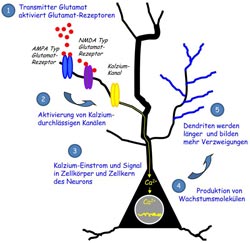The architects of the brain

Growth of dendritic processes: When glutamate docks on to the AMPA receptor, calcium ions flow into the nerve cell. They cause the production of special growth molecules which trigger the extension and branching of the dendrites. AG Entwicklungsneurobiologie<br>
Individual receptor variants lead to especially long and branched processes called dendrites, which the cells communicate with. The researchers also showed that the growth-promoting property of the receptors is linked to how much calcium they allow to flow into the cells. “These results allow insights into the mechanisms with which nerve cells connect during development”, says Prof. Dr. Petra Wahle from the RUB Working Group on Developmental Neurobiology. The scientists report in Development.
It all depends on a few amino acids
“Nerve cells communicate with chemical and electrical signals”, explains Wahle. “The electrical activity controls many developmental processes in the brain, and the neurotransmitter glutamate plays a decisive role in this.” In two different cell classes in the cerebral cortex of rats, the researchers studied the nine most common variants of a glutamate receptor, the so-called AMPA receptor. When glutamate docks on to this receptor, calcium ions flow into the nerve cells either directly through a pore in the AMPA receptor or through adjacent calcium channels. Depending on the variant, AMPA receptors consist of 800-900 amino acid building blocks, and already the exchange of one amino acid has important consequences for the calcium permeability. Among other things, calcium promotes the growth of new dendrites.
Different cell types, different mechanisms
One at a time, the Bochum team introduced the nine AMPA receptor variants into the nerve cells and observed the impact on the cell architecture. In several cases, this resulted in longer dendrites with more branches. This pattern was demonstrated both for several receptor variants that allow calcium ions to flow directly into the cell through a pore and for those that activate adjacent calcium channels. “It was surprising that in the two cell classes studied, different receptor variants triggered the growth of the dendrites”, says Dr. Mohammad Hamad from the Working Group on Developmental Neurobiology. “In the inhibitory interneurons, only one of the nine variants was effective. Calcium signals are like a toolbox. However, different cell classes in the cerebral cortex make use of the toolbox in different ways.”
Bibliographic record
Hamad, M. I., Ma-Hogemeier, Z. L., Riedel, C., Conrads, C., Veitinger, T., Habijan, T., Schulz, J. N., Krause, M., Wirth, M. J., Hollmann, M., Wahle, P. (2011) Cell class-specific regulation of neocortical dendrite and spine growth by AMPA receptor splice and editing variants. Development 138, 4301-4313, doi: 10.1242/dev.07107
Further information
Prof. Dr. Petra Wahle, AG Entwicklungsneurobiologie, Faculty of Biology and Biotechnology at the Ruhr-Universität, 44780 Bochum, Tel.: 0234/32-24367
wahle@neurobiologie.ruhr-uni-bochum.de
Media Contact
More Information:
http://www.ruhr-uni-bochum.de/All latest news from the category: Life Sciences and Chemistry
Articles and reports from the Life Sciences and chemistry area deal with applied and basic research into modern biology, chemistry and human medicine.
Valuable information can be found on a range of life sciences fields including bacteriology, biochemistry, bionics, bioinformatics, biophysics, biotechnology, genetics, geobotany, human biology, marine biology, microbiology, molecular biology, cellular biology, zoology, bioinorganic chemistry, microchemistry and environmental chemistry.
Newest articles

Trotting robots reveal emergence of animal gait transitions
A four-legged robot trained with machine learning by EPFL researchers has learned to avoid falls by spontaneously switching between walking, trotting, and pronking – a milestone for roboticists as well…

Innovation promises to prevent power pole-top fires
Engineers in Australia have found a new way to make power-pole insulators resistant to fire and electrical sparking, promising to prevent dangerous pole-top fires and reduce blackouts. Pole-top fires pose…

Possible alternative to antibiotics produced by bacteria
Antibacterial substance from staphylococci discovered with new mechanism of action against natural competitors. Many bacteria produce substances to gain an advantage over competitors in their highly competitive natural environment. Researchers…





















